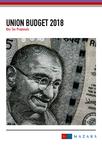Union Budget 2018 | Key Tax Proposals
Core areas of focus stem around agriculture and healthcare, with key highlights being the substantial 1.5x minimum support price (MSP) put in place for Kharif crops, as well as a 5 lakh per family treatment cover for over 10,000 cr poor families. Alongside this, various initiatives will be undertaken towards the development of roads, railways and airports. These include, among others, the Bharatmala project of building 35,000 km of roads and highways, as well as an INR 1.48 lakh cr Railway Capex allocated to set up upgraded stations with proper facilities such as escalators, WiFi connectivity etc. Apart from this, 99 cities have been selected as part of the Smart Cities Mission, receiving an outlay of INR 2.04 lakh cr. Vision is to make India digital across various aspects, with INR 1 lakh cr for education that ultimately has digital boards replace blackboards.
From the business perspective, emphasis has been placed on the growth of MSMEs, with these smaller companies given viable online channels to avail loans, as well as receive tax breaks for turnover of 250 cr. New employees will also be given greater tax reliefs with their EPF contribution in order to boost the domestic market up. With a hike on customs proposed for goods such as mobiles and TVs, it is necessary to create a sizeable working class domestically.
While the government has crossed its fiscal deficit target last year of 3.2% of GDP (actually incurring 3.5%), it has pegged the amount for this year at 3.3%. Tax realization is seen to better off as demonetization and GST settles well in the system. Meanwhile, the imposition of Long Term Capital Gains tax (LTCG), which can dampen investor sentiment in the financial services sector in the short-term, also brings in a sizeable source of potential revenue.
Overall, much of the crux of this current budget lies in pumping money in the poorer sections of society and enabling them to have a greater disposable income in-hand after their basic education/medical needs are taken care of. While this benefit will initially flow in the hands of consumer-goods companies, it may eventually find its way to other sectors in line. Effects of this will only be visible in the long-term.
Click on the link below to download the full report.

